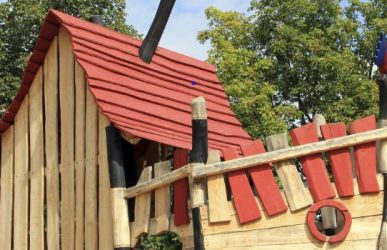Wooden or plastic playhouses?
Buying a wooden or plastic playhouse and not sure which one is best for your child? We’ve scoured the web to see what kids and parents think and offer some of our own suggestions. During our research it was clear that people have lots of opinions on this topic. Some made an honest appraisal between the two and others clearly had an agenda. Our goal is to provide an impartial look at the pros and cons of both options to allow families to make the best choice for themselves.
Budget
 As much as we would all like to be able to buy our children a playhouse that looks like a child-sized mansion (it’s available on Amazon for around $5k), budget does play a part in what toys each family can afford. As a rule, plastic playhouses are less expensive. You can pick new ones up on Amazon from between $100-600 depending upon the size, the accessories and details. They come in a variety of designs, colors and sizes. Some even include fences and mailboxes. You can see a few of our favorites in our article about plastic playhouses.
As much as we would all like to be able to buy our children a playhouse that looks like a child-sized mansion (it’s available on Amazon for around $5k), budget does play a part in what toys each family can afford. As a rule, plastic playhouses are less expensive. You can pick new ones up on Amazon from between $100-600 depending upon the size, the accessories and details. They come in a variety of designs, colors and sizes. Some even include fences and mailboxes. You can see a few of our favorites in our article about plastic playhouses.
Wooden playhouse kits can run from around $300 up to $9,000 (yes, indeed, that’s not a typo). The lower end models are far from a plain wooden box, they can come with hinged doors, windows and even flower boxes. They are often made with cedar siding, shingles and wall studs – meaning they are constructed much like a full-sized house. One of our favorites comes in at the lower end of the price range and offers quite a few charming features.
There are also options in both wood and plastic models to have attached swings, slides and climbing equipment.
Assembling Playhouses
 Both plastic and wooden playhouses will require some assembly. Some wooden playhouse kits only include the hardware and you have to purchase the lumber and other building materials separately. (Make sure you understand what you are getting before buying – that bargain deal might not be the bargain you originally thought.) A consistent refrain from buyers of both wooden and plastic playhouses was that the pre-drilled holes were not always set deep enough and sometimes did not meet; having a drill or electric screwdriver was recommended.
Both plastic and wooden playhouses will require some assembly. Some wooden playhouse kits only include the hardware and you have to purchase the lumber and other building materials separately. (Make sure you understand what you are getting before buying – that bargain deal might not be the bargain you originally thought.) A consistent refrain from buyers of both wooden and plastic playhouses was that the pre-drilled holes were not always set deep enough and sometimes did not meet; having a drill or electric screwdriver was recommended.
Do check out any online reviews you can find. A number of parents and grandparents suggested assembling things in a different order than the supplied instructions made for easier assembly overall. You also might find valuable advice if things don’t go exactly as planned. One parent made an excellent suggestion of turning the roof 90 degrees so rainwater would not drip onto children entering or exiting the house. (Most of the models we saw did that already.)
One option we were surprised wasn’t mentioned was creating a rain collection system. A few small sections of gutter or PVC pipe and a rain barrel might provide a great way to help water an area of the garden that might be out of reach of the garden hose. It could also provide a water source for any landscaping or flowers you and your children plant around the playhouse.
Playhouse Sizes
As a rule the plastic playhouses are smaller. Your children might grow out of the playhouse sooner but their size also makes it possible to use them indoors. They weigh less but that also means they should be better secured when used outside or even inside if your children might play roughly.
Wooden playhouses are generally larger in size and offer more play space; some larger models can offer as much as 100 square feet of covered play area. They weigh more and generally are not moveable once built. They should also be firmly secured to the ground, though some models might weigh enough to not require that extra safety precaution.
Typically, children become too tall to pass through the doorway before the interior space becomes too small. Several families remedied that by building small foundation walls to lift the structure higher off the ground. One clever daddy redesigned their wooden structure to have taller walls.
Unwelcome Visitors
 We found articles with clear agendas promoting either wooden or plastic playhouses claiming one was more inviting to insects or rodents than the other. Let’s be honest here. If the playhouse is kept outside and bees, ants, spiders, raccoons or whatever critters that inhabit your yard take an interest in the playhouse, they might move in. Teach your children to keep their playhouse free from stray food and excess paper that might tempt insects and other critters to make it their home.
We found articles with clear agendas promoting either wooden or plastic playhouses claiming one was more inviting to insects or rodents than the other. Let’s be honest here. If the playhouse is kept outside and bees, ants, spiders, raccoons or whatever critters that inhabit your yard take an interest in the playhouse, they might move in. Teach your children to keep their playhouse free from stray food and excess paper that might tempt insects and other critters to make it their home.
Plastic playhouses can be more easily cleaned if unwelcome guests leave a mess but, their generally open-sided construction makes it easier for them to get in. Most wooden playhouses that we have seen are also fairly open, but some families have inserted plexiglass into the windows to make them more weather and critter-proof.
Parents should take a moment and inspect any outdoor play structure periodically to ensure they are only occupied by children.
Appearance
Let’s face it. A plastic playhouse looks like a plastic playhouse. The manufacturers are adding fences, window boxes and even sky lights to make their outdoor toys look more charming. You can find cottages, cabins and even castles. They are getting away from using bright primary colors and using browns, tans and greens that more readily blend into a backyard landscape. However, the plastic can fade. For the most part, it seems to fade uniformly, but they are not always the most attractive of yard ornaments. A number of families have successfully painted their plastic playhouses to make them look new and inviting again or to match their child’s favorite colors.
Wooden playhouses look like miniature houses. They might not be designed to look like a stone castle but they too have fences, window boxes and sky lights. Just like houses, the wooden playhouses might have to be re-stained or painted from time to time to maintain a fresh appearance. Since they look more like houses, people often feel they are more attractive. Just be sure their more permanent nature doesn’t put you in trouble with your neighborhood homeowner’s association if they ban outdoor buildings.
One thing to consider when evaluating which type of structure best suits your family is visibility. Look for models with more open doorways and windows if you want to be able to see your child from a distance. More enclosed models might provide that more hide-away feel for kids and offer an all-weather option. However, those models make it harder to ensure the children have not left the safety of your yard.
Longevity
Plastic playhouses are tough. We didn’t find anyone complaining that their plastic playhouses fell apart or otherwise deteriorated. They do require a good scrubbing from time to time and can fade, but they generally hold up well. Many families pass them around much like they share baby clothing. Their more lightweight construction and portability make it easier to throw into the back of a truck or minivan and take to the next house.
Wooden playhouses vary a bit in their longevity. We read one review that complained the included boards were so warped that they would only be useful for firewood. That was certainly the exception rather than the rule. Most families reported their wooden playhouses held up well to whatever Mother Nature threw at them. They too can be shared from one family to the next but moving them may prove more difficult. Another option, mentioned by several families, is that once the children outgrew the playhouses, the family stored gardening tools and outdoor toys in them.
One family took that idea a step further and invested in a garden storage shed that had a cottage appearance. Their children were able to use it as their backyard hideout well into their teens and it was a great place to overwinter garden tools and toys. The one downside to this option is that it doesn’t offer that cozy child-sized feel and small children may not be able to see out of the windows.
Wooden vs Plastic Playhouses
The good news is that whichever style you choose, your child can have fun and enjoy hours of safe play. There are plenty of options for style, colors and size in both wooden and plastic playhouses. We consistently saw that regardless of which was chosen the kids loved them and parents had trouble getting them to play with anything else.



